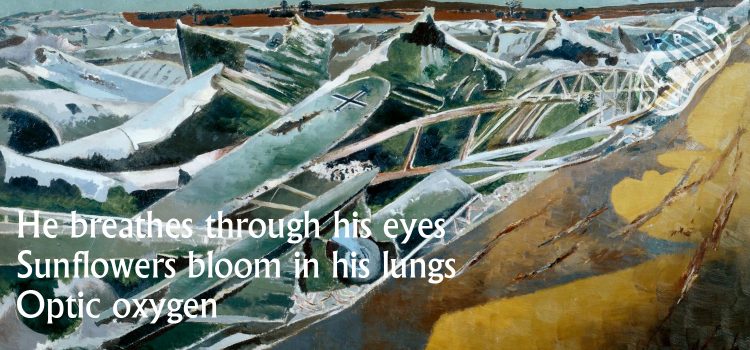
Sue Evans
Paul Nash: Genius loci
Leaving Queen Alexandra Mansions, steadfastly you stride along Bidborough Street, the backs of advertising hoardings on your right, like so many stretched canvases. Cornflowers strafe the sky, clouds in white garlands dance. Sunflowers on red-brick balconies strain to be one with the sun. Onwards along Woburn Walk towards the Slade that venerable art institution. Jeremy Bentham’s unseeing eyes follow you along the path that winds like a stream between the green lawns up to its doors. This place is not for you. Instead Roger Fry says you’ve made an impression. You understand the merging of the fine and commercial arts. You could make a living by design. His Omega Workshops are the last word in style and, clad in soot-black Portland stone, 33 Fitzroy Square their showcase. But more pressing matters await along the Menin Road, its gutted woodland nothing like Fitzrovia plane trees. The ruined country, the void of war seen after the battle. We are making a new world that’s for sure, but with none of the old certainties. You think all we know is lost and only dreams are real. Somebody said ‘God is a shout in the street’. For you, the sacred resides in nature, and the ideal reality this implies. The never-ending cycle of day and night, the sun and moon, speaks of a remote past in an alarming present. Over the horizon the lights go down, voices die away, the last scene of the drama plays out. We are the landscapes we inhabit, the spirit of place. Witness the terrible beauty of Totes Meer.
Image: Paul Nash, Totes Meer (Dead Sea), 1940 – 41, Tate (N05717), digital image
© Tate released under Creative Commons CC-BY-NC-ND (3.0 Unported)
Research Story
Sue Evans
Paul Nash (1889 – 1946)
One afternoon in August I walked to three buildings in Bloomsbury where Paul Nash had a connection, starting at his former pied-à-terre which he shared with his wife Margaret at Queen Alexandra Mansions on Bidborough Street from 1914 until 1936. At the time, Nash’s redbrick mansion block apartment looked onto the back of advertising hoardings facing St Pancras, a view he depicted in three of his paintings in the 1920s.
In 1910 he attended Slade School of Fine Art on Gower Street but didn’t settle there and left after one year. As a designer, illustrator and printmaker, as well as a landscape artist, he had a brief involvement with The Omega Workshops at 33 Fitzroy Square at the invitation of co-founder and Bloomsbury Group member Roger Fry.
Paul Nash was a Surrealist landscape painter at the forefront of the Modern Movement in England during the first half of the twentieth century and uniquely an Official War Artist during both World Wars. The Menin Road and his other paintings depicting the devastation of battle are in the Imperial War Museums’ collection. His signature work from World War II, Totes Meer, is at Tate Britain.
Nash died aged 57 in 1946 from congestion of the lungs, having been troubled with breathing ailments since his early wartime experience. He left behind a significant body of work, his later paintings displaying an exuberance that for me belie his poor health. Sunflowers and the sun are juxtaposed in symbolic landscapes that reflect his deep feelings about nature, especially the spirit of place or genius loci.
